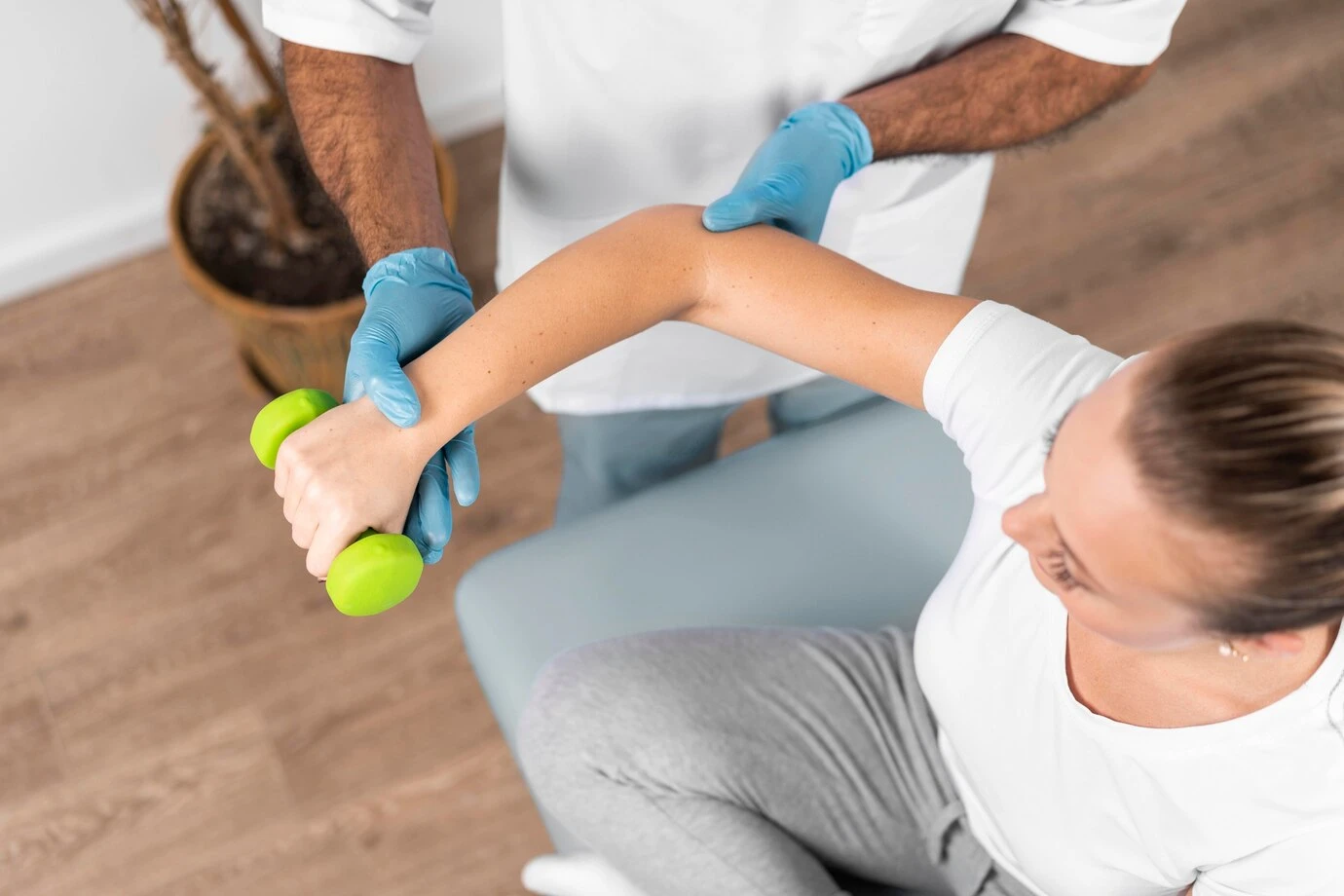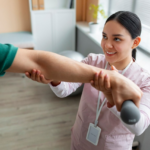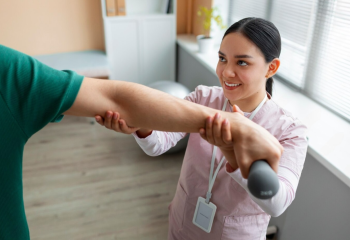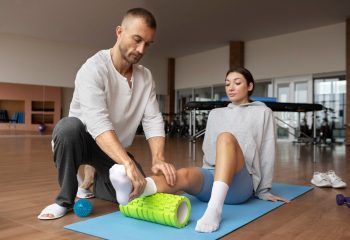The elbow is a complex hinge joint, crucial for a wide range of movements. Connecting the upper arm bone (humerus) to the forearm bones (radius and ulna), the elbow allows us to bend, straighten, and rotate our forearms. Because of its frequent use, the elbow is susceptible to various injuries and conditions.
Two of the most common elbow problems we see are “tennis elbow” (lateral epicondylitis) and “golfer’s elbow” (medial epicondylitis). These overuse injuries cause pain and tenderness around the elbow joint, often making even simple tasks difficult. But these aren’t the only elbow issues we address.
Our skilled therapists have extensive experience in treating a wide spectrum of elbow conditions, including:
- Golfer’s Elbow: Pain on the inner side of the elbow.
- Tennis Elbow: Pain on the outer side of the elbow.
- Medial collateral ligament (MCL) sprain of the elbow: Injury to the ligament on the inside of the elbow.
- Olecranon bursitis: Inflammation of the fluid-filled sac at the tip of the elbow.
- Posterior dislocation of the elbow joint: A painful injury where the bones of the elbow are forced out of alignment.
- Ulnar nerve compression at the elbow (Cubital Tunnel Syndrome): Pressure on the ulnar nerve as it passes through the elbow.
- Fractured radial head: A break in one of the bones of the forearm near the elbow.
- Hyperextension injury of the elbow: Damage caused by overstretching the elbow joint.
- Referred pain to the elbow: Pain originating from another area, such as the neck or shoulder, that is felt in the elbow.
Why the Elbow Matters
The elbow is a hinge joint formed by three bones: the humerus (upper arm), radius, and ulna (forearm). It allows two major movements:
- Flexion and extension (bending and straightening of the arm)
- Supination and pronation (rotating your forearm)
This flexibility is essential—but also makes the elbow vulnerable to injuries and overuse.
Common Elbow Conditions We Treat
Our physiotherapists treat a wide range of elbow conditions, from acute injuries to long-standing pain.
- Tennis Elbow (Lateral Epicondylitis)
Pain and tenderness on the outer elbow, often caused by repetitive wrist extension and gripping. Common in racquet sports, manual work, or computer use.
- Golfer’s Elbow (Medial Epicondylitis)
Affects the inside of the elbow. Caused by repetitive wrist flexion or overuse. Despite the name, it’s not limited to golfers.
- Olecranon Bursitis
Swelling at the tip of the elbow due to direct trauma, pressure (like leaning on the elbow), or infection.
- Ulnar Nerve Compression (Cubital Tunnel Syndrome)
Numbness or tingling in the ring and little fingers, caused by pressure on the ulnar nerve at the elbow. This may worsen at night or when the elbow is bent for long periods.
- Medial Collateral Ligament (MCL) Injury
Often seen in throwing athletes, this is an overstretch or tear of the ligament that stabilises the inner elbow.
- Posterior Elbow Dislocation
When the bones of the elbow become dislodged due to trauma or a fall. This is a serious injury needing urgent care and structured rehabilitation.
- Fractured Radial Head
A break in the bone at the outer part of the elbow, common in falls onto an outstretched arm.
- Hyperextension Injury
Overstretching of the elbow, which can strain the joint capsule and ligaments, resulting in pain and swelling.
- Referred Elbow Pain
Sometimes the elbow hurts due to problems in the neck, shoulder, or even wrist. Our therapists carefully assess the root cause to ensure accurate treatment.
Our Elbow Rehabilitation Approach
Every elbow injury is different. That’s why we start with a detailed consultation and create a customised plan built around your needs and lifestyle.
Initial Assessment
We look at your joint range, pain level, muscle strength, posture, and any contributing factors to your elbow pain.
Manual Therapy
Our hands-on techniques improve joint movement, reduce stiffness, and relieve pain in the elbow and surrounding structures.
Soft Tissue Mobilisation & Dry Needling
We use targeted soft tissue release to loosen tight muscles around the elbow, and dry needling to address chronic muscle tension or trigger points.
Taping and Bracing
We may apply kinesiology taping or provide braces to support the elbow and reduce strain during movement.
Exercise Therapy
You’ll receive a progressive strengthening plan focusing on:
- Forearm and wrist control
- Grip strength
- Triceps and biceps activation
- Shoulder stability (important for supporting the elbow)
Ergonomic & Lifestyle Advice
We’ll teach you how to modify tasks, work setups, or training routines to reduce elbow stress and prevent recurrence.
When to See a Physiotherapist for Elbow Pain
Get in touch with a physiotherapist if:
- Your elbow pain lasts more than a few days
- It’s hard to fully straighten or bend your elbow
- You feel tingling, numbness, or weakness in your hand
- There’s visible swelling, bruising, or deformity in the elbow
- Pain is impacting sleep or daily tasks
The sooner you begin rehab, the better your chances of a complete and speedy recovery.
Get Back to Life Without Elbow Pain
Living with elbow pain can be frustrating. But you don’t have to live with it. With the right physiotherapy, your elbow can recover from injury, regain strength, and move freely again.
At Ace Physio, we help restore function to your elbow, reduce pain, and prevent re-injury—so you can get back to doing what you love, pain-free.
FAQs
Yes, a physiotherapist can effectively treat elbow pain by identifying the root cause, applying manual therapy, and guiding you through targeted exercises to restore function and reduce discomfort.
The best treatment includes rest, ice, physiotherapy exercises, and in some cases, bracing or anti-inflammatory medication—depending on the cause and severity of the elbow pain.
Gentle massage can help reduce tension and improve blood flow, but if the pain is sharp or due to inflammation, it’s best to consult a professional before self-massaging.
Elbow rehabilitation involves reducing inflammation, restoring range of motion, strengthening the surrounding muscles, and gradually returning to normal activities under physiotherapy supervision.
A physiotherapist is usually the first line of care for tennis elbow, as they specialize in non-invasive treatment and long-term recovery, though a doctor can help rule out more serious conditions.
A counterforce elbow strap or compression sleeve can provide support, reduce strain on tendons, and relieve symptoms during activity.
Yes, a physical therapist can help diagnose the issue, guide recovery, and prevent the elbow pain from becoming chronic or recurring.
Mild elbow pain may improve with rest and activity modification, but persistent or worsening pain often requires physiotherapy to heal properly and avoid long-term issues.










